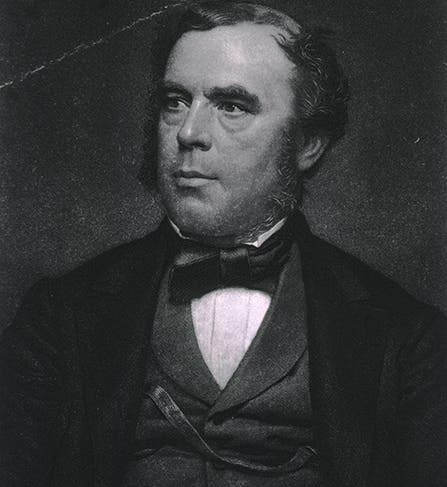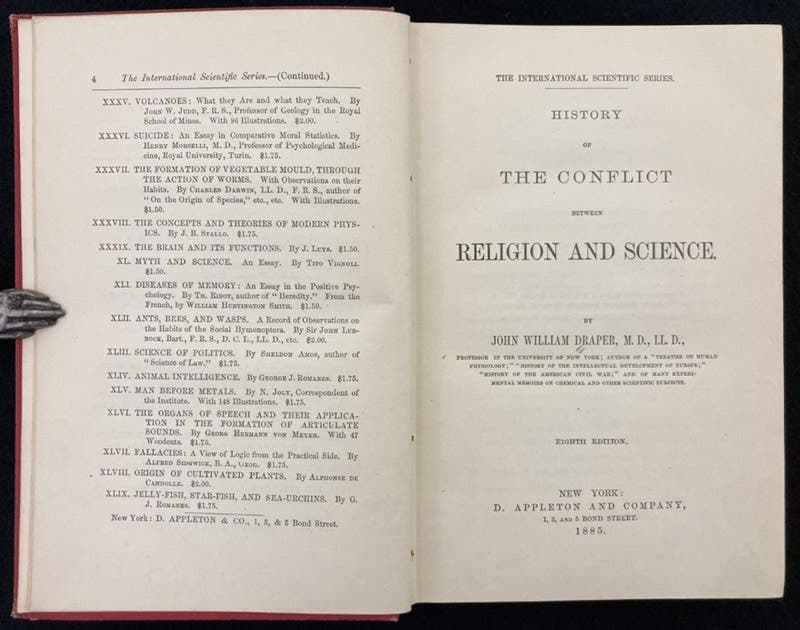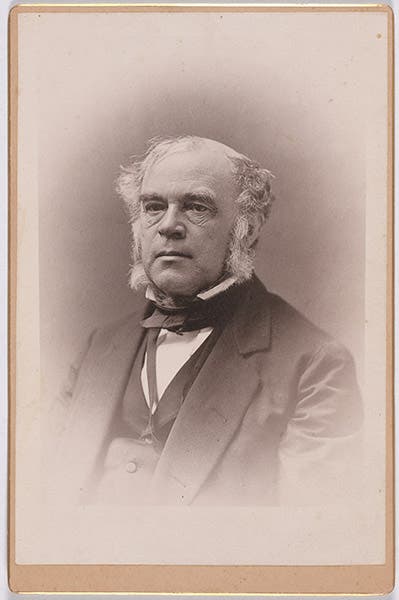Scientist of the Day - John William Draper
John William Draper, a British/American physician and chemist, was born May 5, 1811. Draper came to the United States from England in 1832, received a medical degree from the University of Pennsylvania, moved to New York University in 1837, and in 1840, was one of the founders of NYU's School of Medicine. He taught there for most of his life, serving as president of the med school for 23 years.
Draper, however, like many physicians before him, was as interested in chemistry as medicine. He was one of the first Americans to follow up on Louis Daguerre's discovery of a new photographic process, announced in 1839, and to see the possibilities of photography for science. He took the very first daguerreotype of the Moon in 1840, which we cannot show you here, because of rights restrictions, but which you can see on its webpage at the Metropolitan Museum of Art. Daguerreotypes do not have a long shelf life unless they are carefully preserved from the moment they are taken, so the lunar image has suffered in the last 180 years, but it is still there, a significant astrophotographic first.
Draper played a less distinguished role in the famous 1860 meeting at Oxford University where Darwin's Origin of Species was the subject of discussion. Draper was the invited opening speaker, coming all the way from the United States, but he spoke so long that he was, it is said, booed from the podium, so that the crowd might hear Bishop Samuel Wilberforce rip into Darwin, and then, unexpectedly, hear Thomas Henry Huxley rip into Wilberforce.
Given his interest in medicine, chemistry, and evolution, it is surprising that Draper is best known today for a book on quite a different subject, published in 1874. It was called A History of the Conflict between Religion and Science, where he tried to make the case that, throughout history, science has tried to expand our horizons and the church has tried to confine them, that science and religion have always been at war. This book marked the origin of what has been called the "conflict thesis", which maintains that science and religion are incompatible. There has been considerable effort recently, by historians of both science and religion, to show that that the conflict thesis seriously distorts and over-simplifies the history of science, and that most scientists work within a religious framework and are far from being at war with religion.
As you can see from the title page (second image, just above), Draper’s book was part of a new series, the International Scientific Series (ISS), founded by Edward Youmans. Draper’s book originally appeared in 1874 and was no. 12 in the series; by the time this printing appeared in 1885, as one can see by the facing page, they were up to no. 49. Someday we will write another post about Youmans and his influential ISS, which we did not even mention in our first post.
Before we make our final observation about Draper, let me say something about the two portraits we have included here. The first depicts Draper about fifteen years after he made his daguerreotype of the Moon, and is in the National Library of Medicine, and the second, capturing his likeness about six years after he wrote A History of the Conflict, is in the National Portrait Gallery in Washington, D.C.
As a last point of interest, John Draper was the father of Henry Draper, another noted chemist, who not only did important work in spectroscopy, but whose estate provided Harvard College Observatory and its women observers with the resources to engage in their monumental efforts to classify the stars. You can read all about the younger Draper and his legacy in a superb book, The Glass Universe (2016), by Dava Sobel, a frequent guest writer for our Scientist of the Day feature.
Dr. William B. Ashworth, Jr., Consultant for the History of Science, Linda Hall Library and Associate Professor emeritus, Department of History, University of Missouri-Kansas City. Comments or corrections are welcome; please direct to ashworthw@umkc.edu.







![Columbine, hand-colored woodcut, [Gart der Gesundheit], printed by Peter Schoeffer, Mainz, chap. 162, 1485 (Linda Hall Library)](https://assets-us-01.kc-usercontent.com:443/9dd25524-761a-000d-d79f-86a5086d4774/3829b99e-a030-4a36-8bdd-27295454c30c/gart1.jpg?w=210&h=210&auto=format&fit=crop)
